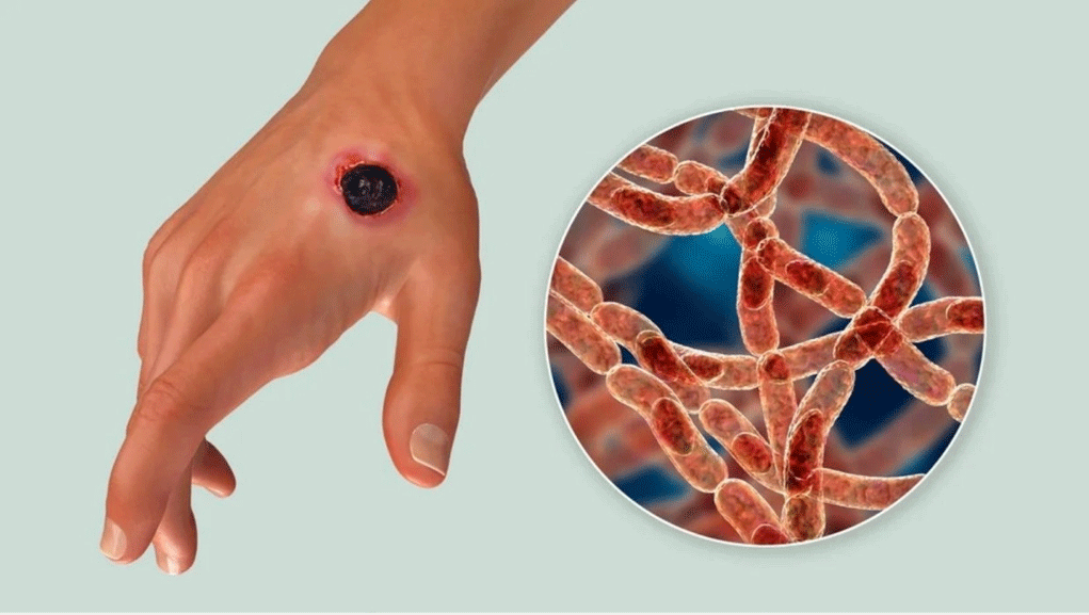Desk Report:
The infectious disease anthrax (takka disease) has been spreading in the country for more than four decades. At different times, the disease has spread to 16 districts, mainly in the northern region. Recently, the disease was detected in cattle in Rangpur and Gaibandha in the northern region. Several infections have also been detected in humans in Rangpur.
There has been concern among marginalized people in the affected areas about the recent spread of anthrax. However, experts say with caution that the disease can be prevented through vaccination of cattle and behavioral changes in people.
History of infection
Anthrax is a disease caused by the bacteria. It has been occurring in cattle for a long time. The disease is not easily transmitted from animal to animal or from person to person. Infection occurs only when the spores or ‘seeds’ of the bacteria enter the body through the mouth, respiratory tract or skin wounds.
In Bangladesh, information about anthrax infection in cattle and from them to humans has been available since 1980. The disease was first detected in Pabna district. Later, infections were seen in Sirajganj, Tangail, Kushtia, Meherpur, Rajshahi, Manikganj, Narayanganj, Lakshmipur, Bogra, Satkhira, Lalmonirhat, Chapainawabganj, Chuadanga, Rajbari and Chittagong. This information has been mentioned in the report of the Institute of Epidemiology, Disease Control and Research (IEDCR) and the study of the US-based scientific journal ‘Helion’ and the Swiss-based scientific journal ‘Frontiers’.
A research paper prepared by analyzing the data of 27 articles published from 1980 to 2023 has been published in the US-based scientific journal Helion. The study titled ‘Animal, Human and Environmental Perspectives of Anthrax in Bangladesh’ says that more than 6,000 animals have been infected from 1980 to 2022. Of these, 15.7 percent died. It says that the risk of human infection with anthrax increases by slaughtering infected animals and coming into contact with raw meat or blood while cutting their meat. Anthrax germs spread in the environment in various ways, including dumping dead animals in water bodies.
‘One Health’ approach to control
Related researchers said that a ‘One Health’ approach is needed to take effective steps to control the spread of anthrax. This approach includes not only animal vaccination, but also changes in human social behavior and lifestyle, environmental management and regular surveillance activities. Through this, it is possible to reduce the outbreak of the disease and carry out coordinated activities to prevent infection.
According to the study by Helion, since 2009, infections in both animals and humans have increased significantly in Bangladesh. Most cases of cutaneous anthrax (skin anthrax) have been identified in humans. Both animals and humans in Pabna, Sirajganj, Tangail and Meherpur are at risk of infection, especially due to environmental, geographical and cultural reasons. Along with these four districts, Kushtia and Rajshahi are considered anthrax-prone areas. Apart from these, multiple outbreaks have occurred in Manikganj, Narayanganj, Bogra, Chapainawabganj, Chuadanga, Laxmipur and Chittagong.
Reasons for the spread of infection
The aforementioned study said that the main reasons for the increase in anthrax infection in cattle are low vaccination, insufficient supply of vaccines, consumption of contaminated grass or water, improper treatment and improper burial of dead animals. Human anthrax usually occurs after infection in animals. There is a risk of infection in humans when slaughtering infected animals and coming into contact with their raw meat, blood, skin and other animal products. The risk of infection for a person who slaughters sick animals is about 22 times higher. The risk for those involved in raw meat handling is about two times higher. If dead bodies or animal waste are not properly managed, anthrax germs can persist in the environment for a long time.
Dr. Sheikh Shahinur Islam, the lead researcher of the above research paper and Deputy Director of the Department of Livestock, said, “The risk of anthrax lies in the connection between the environment, animals and humans. Animals are infected from the soil, and it spreads to humans through animals. The concentration of this germ can be high in the soil, especially in the Jamuna basin area of North Bengal. The main way to prevent this is to vaccinate animals, raise awareness, change behavior and treat them promptly.”
Human infection was more in Meherpur
A study published in the Swiss-based scientific journal Frontiers titled ‘Risk Factors Associated with Cutaneous Anthrax Outbreak in Humans in Bangladesh’ said that 61 percent of the suspected patients between 2013 and 2016 were in Meherpur. Most of the infected people were involved in animal husbandry and management. In 2019, based on previous outbreaks, intensive surveillance was carried out in various upazilas of Sirajganj, Pabna, Meherpur, Tangail and Rajshahi. Since 2020, most of the human infection data has come from Meherpur district. In 2023, 142 samples of 655 suspected patients were tested and the disease was detected in 78. Almost all human infections that year were found in Gangni upazila of Meherpur. In addition, data on 2500 suspected patients was collected in 16 districts between 2010 and 2017.
Dr. Tahmina Shirin, director of the government institution IEDCR, told Ajker newspaper on Sunday that this time samples have been collected from people in various upazilas of Rangpur. 12 from Pirgachha, 4 from Kaunia and 5 from Mithapukur.
T-Out of a total of 21 samples, 11 have tested positive.
Dr. Tahmina Shirin said that the sample information has been provided to the Department of Health. Treatment and community awareness activities are being carried out as per the guidelines. She also mentioned that the Department of Livestock is carrying out vaccination activities.
Three types of human anthrax
According to IEDCR, there are three main types of anthrax in the human body – cutaneous, digestive and respiratory anthrax. Cutaneous anthrax is the most common. About 95 percent of infections are of this type. The patient recovers with the use of appropriate antibiotics. The risk of death is low. Digestive anthrax infection occurs through eating the meat of infected animals. The mortality rate is 25 to 75 percent. So far, no cases of this type of infection have been confirmed through testing in Bangladesh. Respiratory anthrax is extremely rare and deadly. Initially, its symptoms are like the common cold. After temporary relief, the patient quickly develops fever, shortness of breath and shock. If treatment is not given within the first 48 hours, the mortality rate is about 95 percent.
Expert advice and words of the authorities
Former Chief Scientific Officer of IEDCR and advisor to the organization Dr. Mushtaq Hossain said that although there is information about cattle deaths due to anthrax in the country, the human mortality rate is still unclear. He said that to prevent the spread of the disease to humans, it is important to avoid slaughtering sick animals, cover any wounds on the body, and vaccinate animals. It is important to ensure awareness and regular health check-ups of those who cut animal meat. Mushtaq Hossain also urged the ‘One Health’ strategy, where the connection between animals, humans, and the environment is considered.
Director (Disease Control) of the Department of Health, Professor Dr. Halimur Rashid, told Ajker Patrika that the government is taking necessary measures. Local administration and civil surgeons are collecting information and taking precautions. Patients are being treated according to the guidelines. And the Department of Livestock is vaccinating animals.




